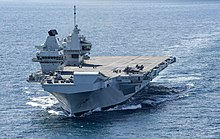Project Vixen
Project Vixen is the name of a Royal Navy programme examining the use of fixed-wing unmanned aerial vehicles (UAVs) from its two aircraft carriers. The project likely draws its name from the de Havilland Sea Vixen, notable for being the Royal Navy's first two-seat carrier-based aircraft capable of supersonic flight.[1]
Background

The Royal Navy operates two aircraft carriers of the
Overview
On 24 March 2021, Project Vixen was first revealed to the public as a programme to evaluate the use of fixed-wing UAVs from the Queen Elizabeth-class.
According to an official Royal Navy publication, titled Future Maritime Aviation Force, which was originally published in December 2020, the Royal Navy aims to replace its helicopter-based airborne early warning (AEW) platform, the Merlin HM2 Crowsnest, with a fixed-wing UAV, currently known as Vixen, by 2030. The Royal Navy also expects to utilise Vixen in surveillance, air-to-air refueling, electronic warfare and strike roles.[11]
In September 2021, the Royal Navy launched a fixed-wing UAV from an aircraft carrier for the first time when a
Relation to RAF LANCA programme
In 2015, the RAF launched its Lightweight Affordable Novel Combat Aircraft (LANCA) programme to deliver a fixed-wing UCAV to augment its fighter aircraft. The Spirit Mosquito, developed by Team Mosquito, was selected as a technology demonstrator for this programme. Vixen was likely to be derived from LANCA or even be identical to it; in July 2020, RAF Air Chief Marshall Sir Michael Wigston stated: “The RAF envisions an aircraft derived from LANCA’s Mosquito phase being used on the Royal Navy’s aircraft carriers alongside F-35B Lightnings”.[14] However, on 24 June 2022, the MOD announced the cancellation of Project Mosquito due to other "more beneficial" and cost-effective solutions being available. It is currently unknown how this affects Project Vixen.[15]
References
- ^ a b c Lye, Harry (24 March 2021). "Royal Navy Project Vixen exploring potential Carrier UAS". Naval Technology. Retrieved 31 March 2021.
- ^ Majumdar, Dave (5 October 2018). "New Carrier, New Fighters: The F-35B Is Now Aboard Britain's Queen Elizabeth Aircraft Carrier". The National Interest. Retrieved 2 April 2021.
- ^ "Cats, traps and claptrap. Why the Royal Navy's new aircraft carriers operate VSTOL aircraft". Navy Lookout. 19 October 2019.
- ^ "Unmanned Air Vehicles". They Work For You. 25 November 2012. Retrieved 31 March 2021.
- ^ "Aircraft Carriers: Unmanned Air Vehicles". They Work For You. 2 March 2016. Retrieved 31 March 2021.
- ^ "Aircraft Carriers: Unmanned Air Vehicles". They Work For You. Retrieved 31 March 2021.
- ^ "Royal Navy looking for heavy lift drone". UK Defence Journal. 1 January 2021. Retrieved 2 April 2021.
- ^ "Maritime Enterprise Planning Group" (PDF). GOV.UK. Retrieved 2 April 2021.
- Aviation Week. 1 March 2021. Retrieved 31 March 2021.
- ^ a b Lye, Harry (9 March 2021). "Royal Navy seeking information on cats and traps to launch drones". Naval Technology. Retrieved 31 March 2021.
- ^ Allison, George (2 April 2021). "Royal Navy looking at fixed-wing carrier based drone for AEW". UK Defence Journal. Retrieved 7 April 2021.
- ^ "Drones launched from HMS Prince of Wales during landmark demonstration". Royal Navy. 29 September 2021. Retrieved 27 October 2021.
- ^ "Royal Navy Is Experimenting With Launching Jet-Powered Drones From Its New Carriers". The Drive. 30 September 2021. Retrieved 27 October 2021.
- ^ "Cats, traps and UAS – the Royal Navy considers options for carrier-launched drones". NavyLookout. 14 April 2021. Retrieved 19 September 2021.
- ^ Allison, George (25 June 2022). "Mosquito drone project swatted". UK Defence Journal. Retrieved 25 June 2022.
